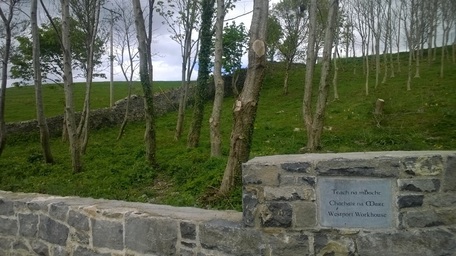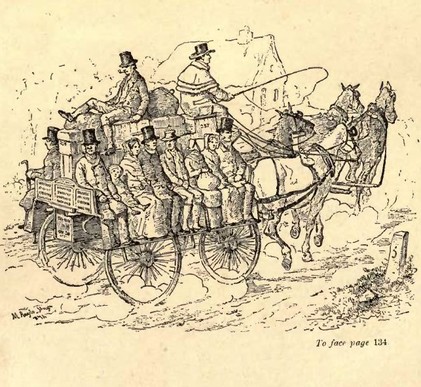Westport Workhouse
Westport workhouse opened in 1845. More information can be found on Peter Higginbotham's website www.workhouses.org.uk/Westport.
The Westport workhouse has been completely demolished, and the site is now predominantly occupied by a housing estate. However, it is marked with a small plaque, and a memorial cross stands atop the burial mound of the workhouse cemetery.
The Westport workhouse has been completely demolished, and the site is now predominantly occupied by a housing estate. However, it is marked with a small plaque, and a memorial cross stands atop the burial mound of the workhouse cemetery.
Westport Workhouse Records
The Minute Books of the Board of Guardians of the Westport Union are held at the National Library of Ireland (NLI) in Dublin. The Westport Union sent the least number of candidates from Mayo to Australia as part of the Scheme, only ten girls, yet their Minute Book records are the most informative regarding both the girls themselves and the operation of the Scheme.
The minutes of 30 August 1849 specify the full particulars required under the Scheme as dictated by the PLC, including requirements of medical examinations and certificates declaring good character. The minutes also reveal that the ten girls were chosen by “the Vice Guardians, in company with Lieut Henry RN Government Emigration officer”. Most importantly, their names and electoral divisions are given:
The Minute Books of the Board of Guardians of the Westport Union are held at the National Library of Ireland (NLI) in Dublin. The Westport Union sent the least number of candidates from Mayo to Australia as part of the Scheme, only ten girls, yet their Minute Book records are the most informative regarding both the girls themselves and the operation of the Scheme.
The minutes of 30 August 1849 specify the full particulars required under the Scheme as dictated by the PLC, including requirements of medical examinations and certificates declaring good character. The minutes also reveal that the ten girls were chosen by “the Vice Guardians, in company with Lieut Henry RN Government Emigration officer”. Most importantly, their names and electoral divisions are given:
Confirmation of the girls’ names and electoral divisions is significant in revealing the individual stories of those who left Mayo. On official immigration documents compiled on arrival in Australia, the ‘Native Place’ of three of the girls (Mary Gibbons, Mary McNamara, and Bridget MacNamara) is given as “Westport”, however, the Minutes provide more accurate information, recording that they come from Aughagower and Achill.
The minutes give details of supplying the outfit requirements for the girls, with an itemised list of suppliers and their corresponding orders, quantities and charges, indicating what was needed. Materials were purchased from three suppliers to make cloaks, gowns, petticoats, caps, stockings, and chemises, as well as purchasing gloves, combs, and knitting needles, among other items.
The minutes also give further information about the conveyance of the girls to Dublin. The Guardians’ meeting of 13 September 1849 described:
“their conveyance to Mullingar per Bianconis Day Car which leaves Westport at 4 oclock am on 21 Inst. and thence per Rail to Dublin so that they are to arrive in Dublin on the evening of 21 Inst. They have also instructed Mrs Bell the Matron of the Workhouse to be prepared to take charge of the young women to Dublin on that day, and the passage money from Dublin to Plymouth will be intrusted to her”.
The minutes give details of supplying the outfit requirements for the girls, with an itemised list of suppliers and their corresponding orders, quantities and charges, indicating what was needed. Materials were purchased from three suppliers to make cloaks, gowns, petticoats, caps, stockings, and chemises, as well as purchasing gloves, combs, and knitting needles, among other items.
The minutes also give further information about the conveyance of the girls to Dublin. The Guardians’ meeting of 13 September 1849 described:
“their conveyance to Mullingar per Bianconis Day Car which leaves Westport at 4 oclock am on 21 Inst. and thence per Rail to Dublin so that they are to arrive in Dublin on the evening of 21 Inst. They have also instructed Mrs Bell the Matron of the Workhouse to be prepared to take charge of the young women to Dublin on that day, and the passage money from Dublin to Plymouth will be intrusted to her”.
|
The first part of the girls' long journey to Australia was via a ‘Bianconi’s Day Car’, which was an uncovered horse-drawn coach operated by Charles Bianconi from c.1815. It was a very popular, and relatively inexpensive, form of travel in nineteenth-century Ireland, and used for long-distance travel in areas where there was no railway line. More information can be found on the National Museum of Ireland's website here.
The Westport workhouse girls joined the group who travelled on the Panama, which departed from Plymouth on 6 October 1849 and arrived in Sydney on 12 January 1850.
|
© Barbara Barclay (2015)




